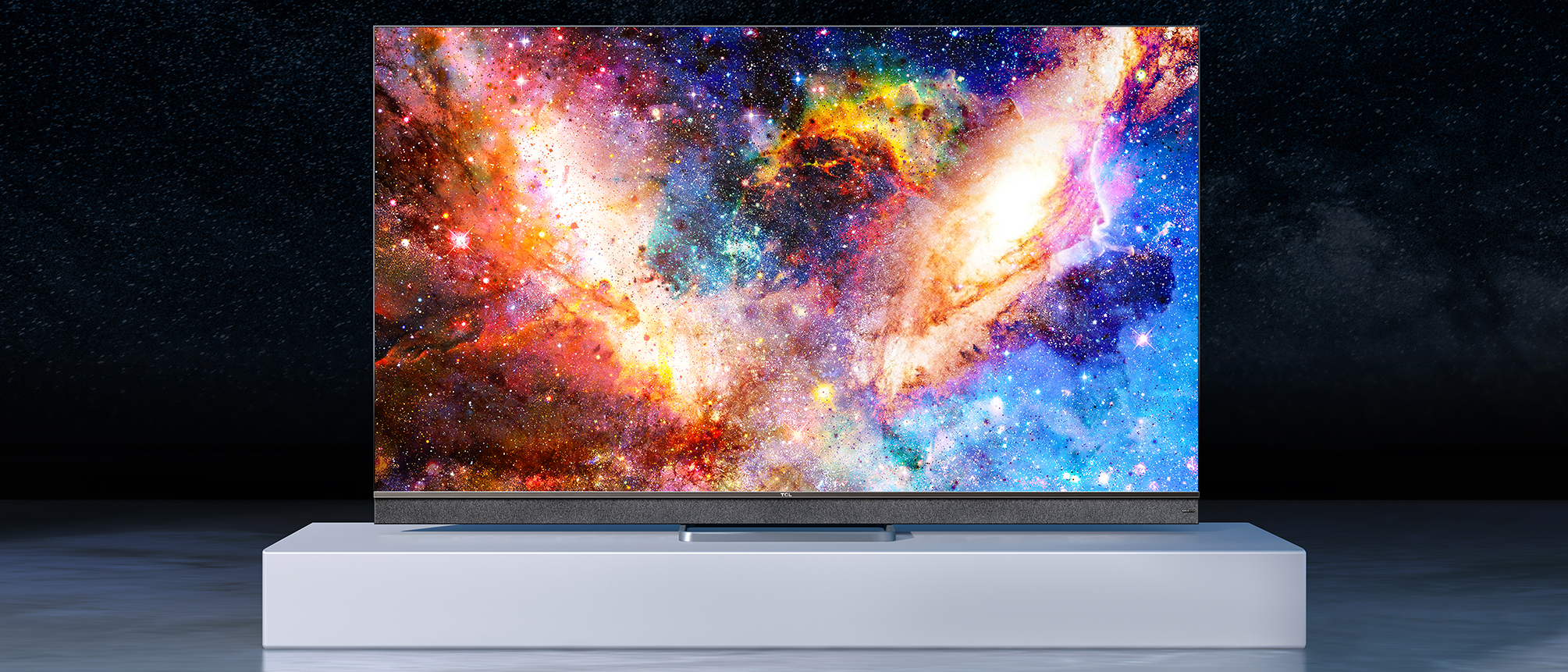Sound+Image Verdict
While it's not quite OLED, this TCL Mini LED TV gets you most of the way there, and with its integrated soundbar the C825 is an excellent value proposition with very little to fault for the low price.
Pros
- +
OLED-level blacks and dynamics
- +
Excellent colours
- +
Useful integrated soundbar
Cons
- -
Nothing at this price
Why you can trust What Hi-Fi?
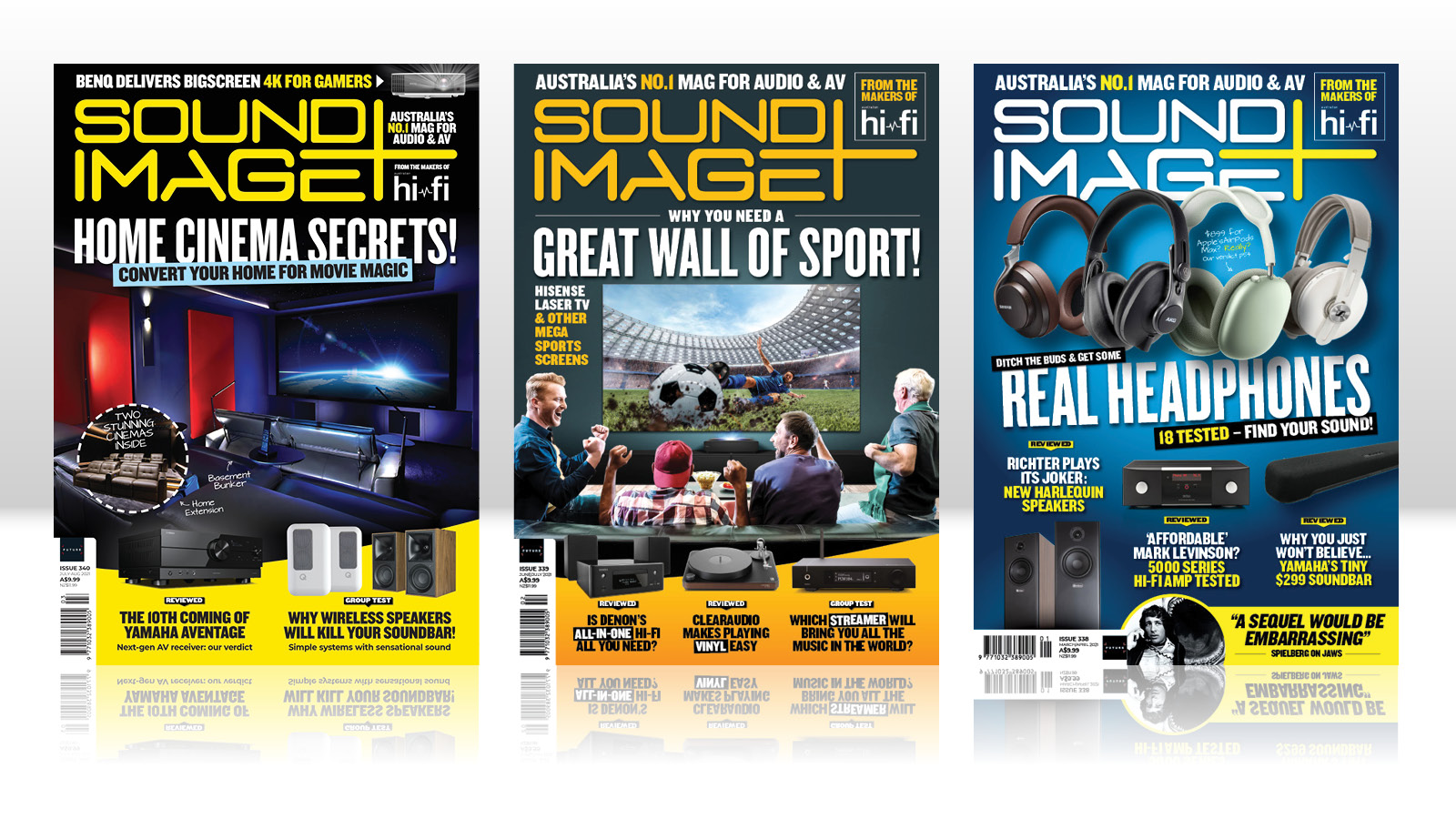
This review originally appeared in Sound+Image magazine, one of What Hi-Fi?’s Australian sister publications. Click here for more information on Sound+Image, including digital editions and details on how you can subscribe.
This TCL C825 television uses ‘Mini LED’ technology. The Mini LED concept groups thousands of tiny LEDs into 128 dimming zones on this 55-inch model (160 zones on the 65-inch), backing a Quantum Dot colour layer and an LCD panel. And in that respect it seems a conceptually simple enough advance on the fewer zones, fewer lights of the past.
So the surprise comes when you see TCL’s analysis of the results of this change, and particularly its comparison with OLED, still regarded by many, ourselves included for the most part, as the TV technology du jour in areas such as contrast and HDR, if not in absolute brightness.
OLED’s ability to display low-level detail at even 0.001 nits allows 19 ‘stops’ (iterative doublings of brightness) in dynamic range up to peak brightness of perhaps 700-1000 nits, with average brightness levels around 150 nits.
But this Mini LED panel, from TCL’s subsidiary CSOL (China Star Optoelectronics Technology), now claims the same low-level display ability of 0.001 nits, while its average brightness is more than three times that of OLED, achieving an overall dynamic range of 20 stops. Then there’s colour – TCL’s Mini LED claims to deliver fully 100% of the DCI-P3 colour volume compared with OLED’s 70%.
Indeed TCL claims Mini LED to be the equal of OLED’s darks and wide viewing angles, and its superior in peak brightness, average brightness, dynamic range, colour volume and the possibility of burn-in none with Mini LED). If this is so, then, can we conclude that OLED’s day in the sun may be finally over?
Build and facilities
TCL’s C825 is an attractive set, the metal frame presenting a couple of millimetres surround to the panel, and a panel bezel of another 4mm around the picture itself, which TCL designates as representing a 99% picture-to-body ratio.
The back of the TV stays quite thick in the centre portion, able to house a useful rear bass driver, while at the edges the entire TV is only 23mm thick on the 55-incher we had for review. Indeed we note that in Europe the C825 series will be available in only this 55-inch and a larger 65-inch TV; in Australia – Lucky Country that we are – we will get also 75-inch and 85-inch models.
The latest hi-fi, home cinema and tech news, reviews, buying advice and deals, direct to your inbox.
It was pleasingly easy to set up, too, with a single-piece stand connected via four screws to the very bottom of the TV rather than to the back, as is more usual; this has the advantage that you can lay the TV on its back rather than its front while connecting the stand, a less fraught procedure.
The stand leaves the TV panel 8cm up from the desktop, with the gap to the stand filled by the integrated soundbar, wrapped in on-trend grey fabric and branded to Onkyo, though the cachet imparted by Onkyo may be tempered temporarily for those aware that Onkyo is currently under its second offer of buyout in as many years (an abandoned bid by Sound United now replaced by one from Voxx, parent of Klipsch).
Branding exercises aside, however, this is a useful three-way speaker system with mid and tweeter drivers in the bar, and that woofer on the back handling 60-200Hz – though in a slightly vulnerable position when you’re moving the TV. TCL says it has aimed for a flat response curve from the audio system when operating at 85dB SPL.
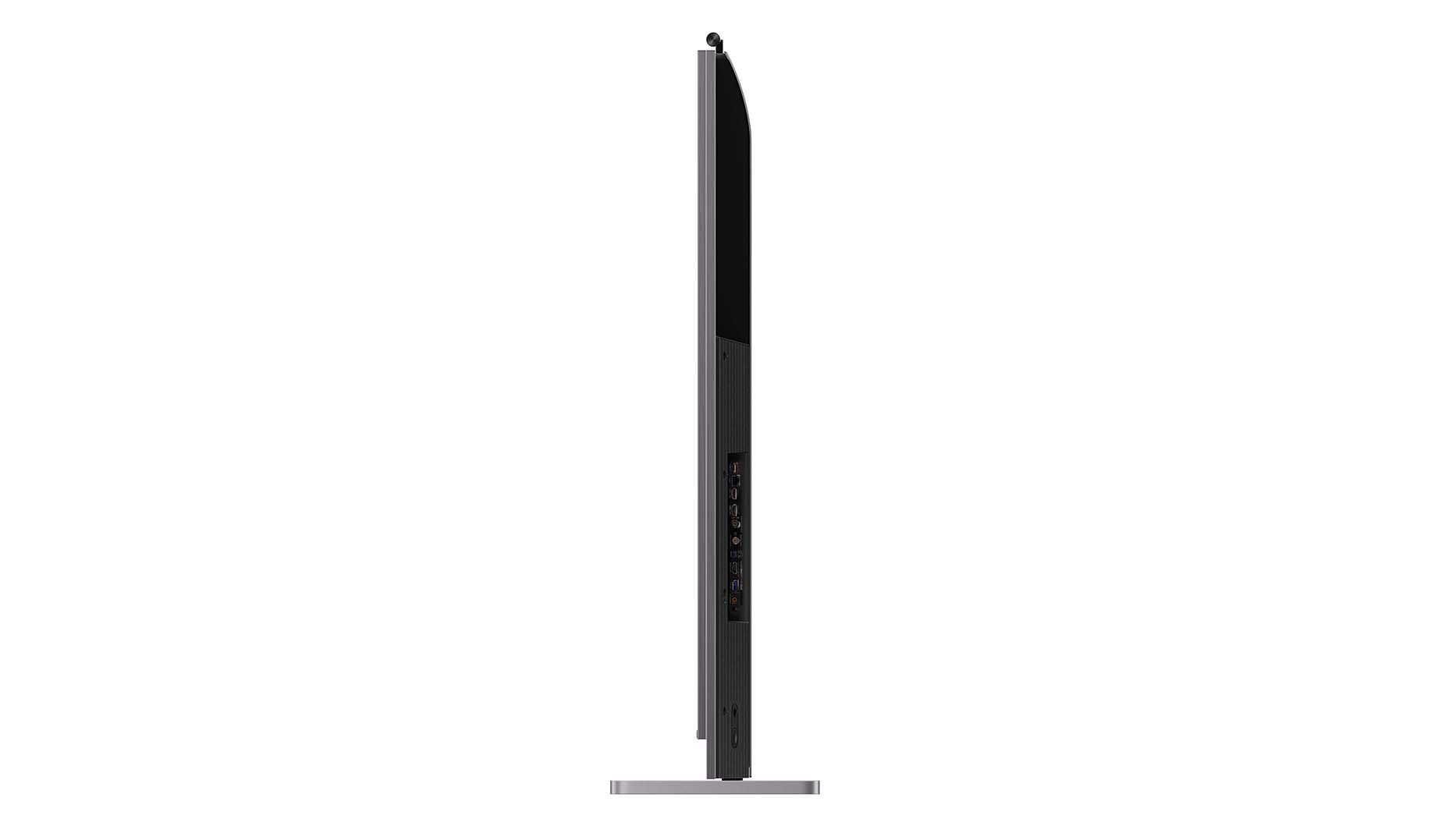
The connections are all side-facing and positioned on the right (worth consideration if you’re replacing a TV with connections on the left). There are four HDMI inputs, with various labels.
The first includes eARC, the enhanced version of the Audio Return Channel, capable of carrying audio in both stereo and surround to a connected audio system, so this is where you’d plug a connection from an AV receiver or external soundbar; there are also optical digital and minijack analogue audio outputs.
TCL tells us that all are HDMI 2.1, but with HDMI 2 supporting 4K/120, so suited, along with other TCL gaming credentials, for the latest generation games consoles. The last two are limited to 4K/60, even though they are HDMI 2.1, says TCL Australia. There’s a composite AV input on a minijack with a supplied conversion cable, and the usual antenna input.
If you’re not going to use the integral soundbar you can take audio out of the HDMI ARC, from an optical digital output, or from the headphone socket. Networking is available using the Ethernet port or the built-in Wi-Fi.
Mini LEDs and dimming zones
As noted, this 55-inch panel is backed by Mini LEDs in 128 dimming zones, while the 65-inch version has 160 zones, and we gather the 75-inch will have 240 zones. The upcoming 8K TCL Mini LED TVs (the X925 range, due by the time you read this) will have still more, topping out with the 8K 85-inch’s 2000 separate dimming zones.
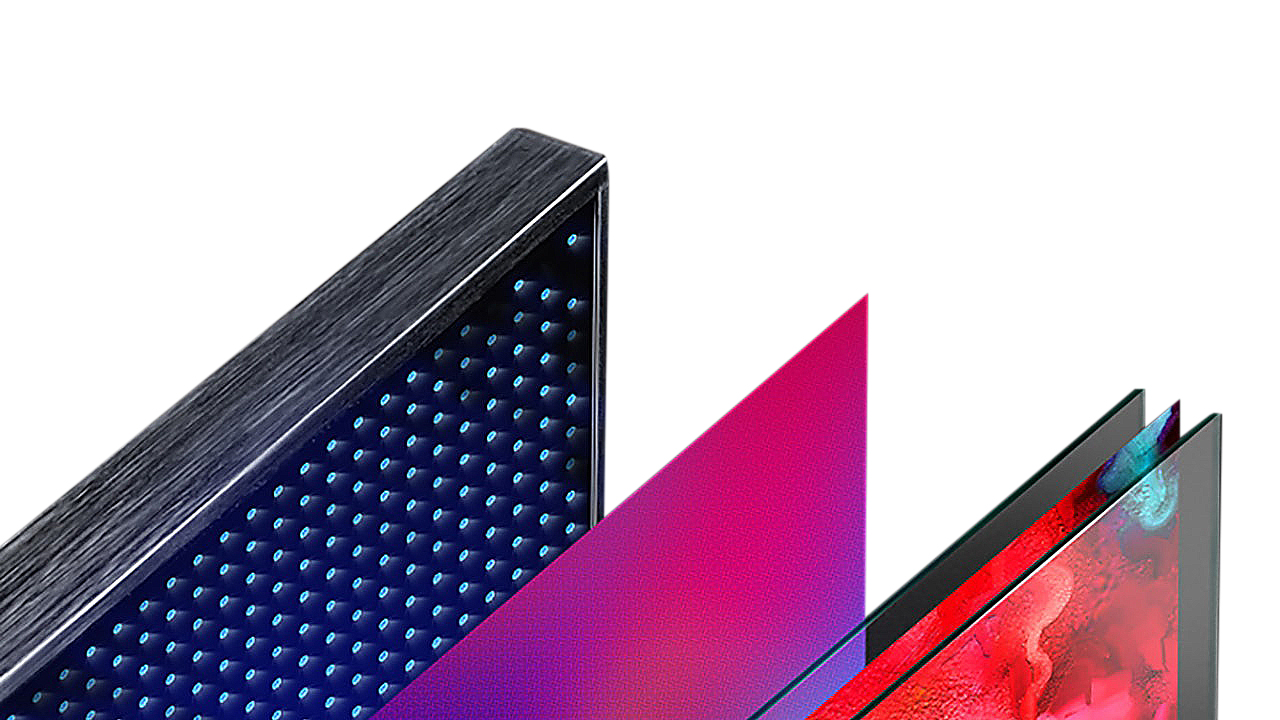
If this 55-inch’s mere 128 zones seem rather crude by comparison with such a number, TCL Europe’s Marek Maciejewski would disagree, noting in a recent presentation to EISA editors that our ability to discern dimming zones is limited to 4° of resolution, equivalent to 144 zones on a 65-inch when viewed from a normal viewing position, so that TCL’s numbers exceed what should be discernable.
Perhaps still more to the point, the main negative effect of dimming zones, which is a ‘bloom’ or halo of light around a bright object isolated on a dark background, has been directly addressed by blooming/halo suppression algorithms in these TCL TVs. They may not do well when displaying star fields, notes Maciejewski, but for real-world material this allows all those OLED-like advantages to be delivered halo-free.
Android TV
Once networked the TCL offers an Android TV interface using Android 11, which we gather should be upgraded to Google TV later this year, to add still further functionality, such as voice search, a watchlist, and smart home control.
Meanwhile there’s the vast resource of TV-compatible Android apps available, and the TCL remote control usefully offers dedicated buttons for Netflix, Stan, Amazon Prime and Disney+. All the usual suspects are either already on the apps bar or awaiting download, including all five catch-up apps, Binge, Optus Sport, Kayo, Foxtel, Tubi and more.
There’s also a ‘TCL Channel’ which both organises other content and offers 19 ‘live’ channels of additional content, though nothing (for us, at least) to get too excited about, and some of them (disappointingly including Drinks TV) failed to load when selected.

One bonus in the box is a little camera which connects into a slot at the top of the TV, replacing a removable rubber seal. The camera has a sliding switch on its back which disables the camera for those with privacy concerns; it might be more convenient if this status could be seen from the front, rather than the rear, but a light comes on when it’s operating (and off, we assume, perhaps naively, when it’s not).
The camera can be used for Google Duo, and also gesture control when using the Media Player, which rather impressively proved able to stream recordings from our Fetch TV elsewhere on the network.
You raise your palm to get the camera’s attention, then can ‘hitch-hike’ with your thumb to scan forward or backwards, or do an ‘OK’ gesture to pause and play, or put your finger to your lips for mute/unmute. It worked remarkably well, though really the remote control is quicker. Any external UVC-compatible webcam will also work for this, we’re told.
There is Google Assistant built into Android TV, of course, and the TV has a mike included, switched on (or off, for those with privacy concerns) by a toggle switch at the set’s back right. In our testing, operation was glitchy if we pressed the button on the remote, but effective if we said the usual “Hey Google”, our question appearing on the screen and easily actioning requests like “Go to HDMI 1”, as well as any old Google enquiry.
One morning we had lost the remote control and managed to get things running almost entirely by voice command, which is about as good an implementation as we’ve yet enjoyed on a TV. It is, of course, possible for Google Assistant to be triggered by words coming from the television itself; interestingly the phrase “Why does the Dwarf stare at you, Tauriel?” does this, but only when spoken in woodland Elvish.
Those preferring Alexa control can select “Works with Alexa” in the System menu, enabling the TCL Assistant Skill through the Alexa Skills Menu to work with an external Alexa device such as a Dot.
In use
When you fire up the TCL for the first time, the brightness is truly remarkable. We had our computer connected to one of the HDMI ports, and its white desktop set the TCL’s screen utterly ablaze.
Switching to the Android TV home interface we saw the first evidence of the panel’s dynamic range and contrast, with bright icons popping against deep black backgrounds.
This clarity and sharpness was equally evident as we moved to 4K Blu-rays. We loaded the remaster of the second Hobbit movie, and even before it began we were pausing the MGM and New Line logo sequences to examine how very black were the blacks – indistinguishable from the non-picture panel area – and how there was no apparent bloom around even small letters and bright shapes.
Every time we thought we could see bloom, masking off the object showed how the bloom was the result of our own perception, not the screen’s delivery.
Once into the movie content, it’s hard to isolate the effects of TCL’s processing on the final image quality. This TV uses the AiPQ Engine Gen 2 processor debuted by TCL at IFA in Berlin last year, with its ability to optimise settings according to content – “so oceans appear bluer and rainforests lusher”.
The HDR performance certainly benefits from the 20 stops of dynamic range, and from selectable dynamic tone mapping, so that should the HDR content be defined right up to 4000 nits, the brightest whites won’t simply crush, they’ll be mapped to the abilities of the panel.
This setting also brings up shadow detail significantly, which can require some brightness adjustments to prevent being excessive. It’s a crucial inclusion, yet for reasons unknown, the UK C825 model doesn’t have the dynamic tone mapping.
There’s selectable and customisable motion interpolation available, but we found it excessive in a number of the default picture settings, delivering that posterised video look. This is the effect at which Hollywood aimed its guns a few years back, spurring the arrival of various ‘Filmmaker’ modes, most of which simply turn off motion processing.
Here the equivalent is the ‘Movie Mode’, which we certainly favoured for The Hobbit, once we had returned the colour temperature slider back from ‘Warm’ to ‘Normal’. The result was a delight, and the utility of the HDR signal evident whether we were admiring the details in a shadowy Prancing Pony bar or the brightness of a shining dawn with wargs silhouetted in the foreground.
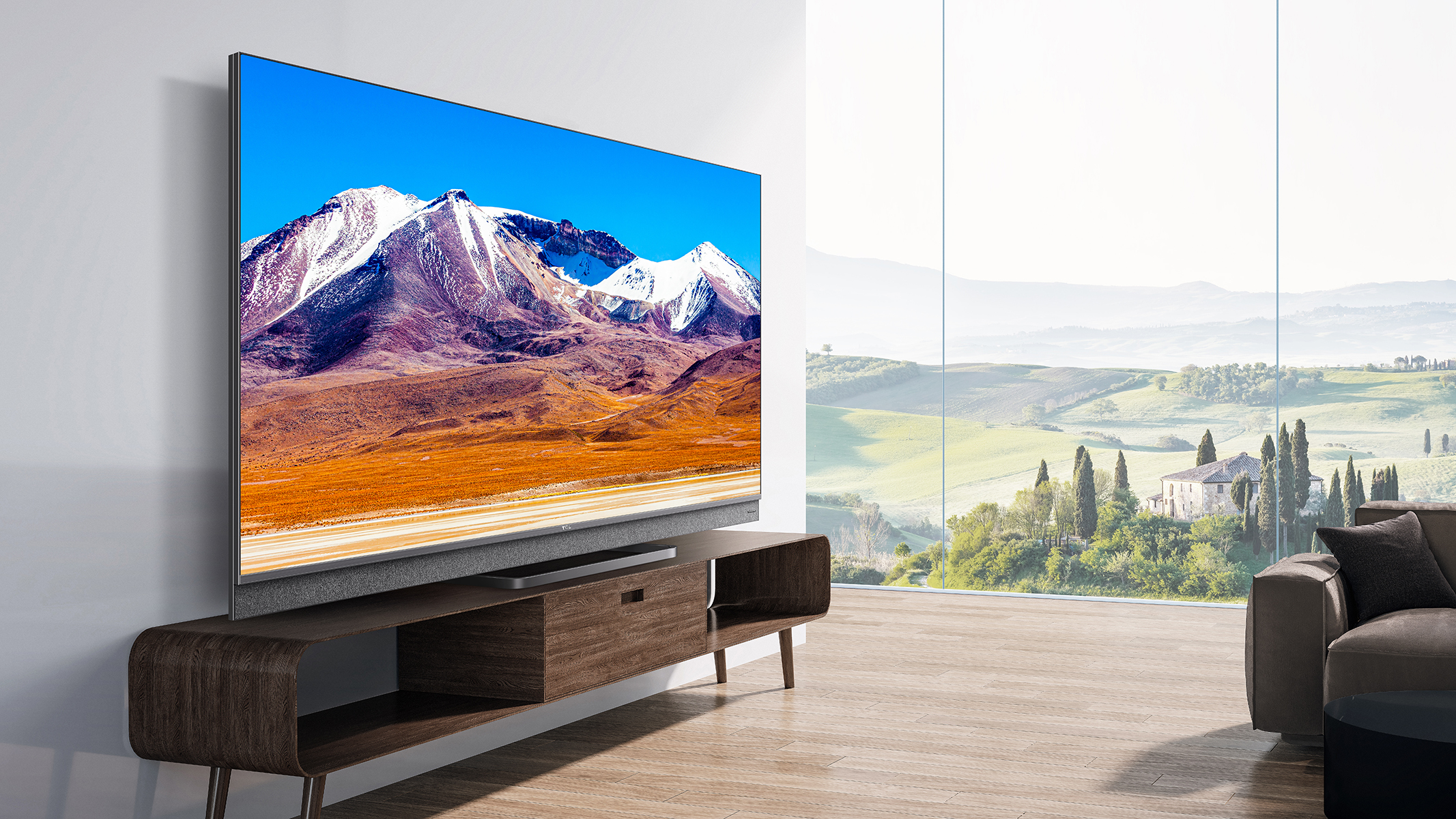
Curiously this all changed after a firmware update, when the Hobbit movie’s Dolby Vision HDR invoked an automatic selection of Dolby Vision IQ as picture mode, but with options for Dolby Vision Light, Dark, and Game. This, however, removed any ability to influence motion settings.
We didn’t mind; the movie looked incredible, the combination of spectacular detail and rapid motion sequences – such as the extended barrel-borne fight sequence – absolutely stunning.
Whether by fundamental performance or AI processing the colours were equally impressive – it’s one thing to read the claim of meeting 100% of the DCI-P3 colour gamut but quite another to enjoy such rich greens and purples, and impressively natural skin tones, especially when combined with extraordinary texture detail available from a good 4K Blu-ray.
It’s a performance level we’ve seen from only one other screen technology – OLED. TCL is not overstating its case in considering Mini LED technology to be achieving the same qualities – the brightness and colours popping out of the sheer blacks, the three-dimensionality of imaging that this imparts.
The other gift of the AiPQ processor is its upscaling. When we used the same 4K Blu-ray player to send ABC iView catch-up to the TCL, the Movie Mode was wholly inappropriate and delivered notable judder on the panning shots opening The Hollow Crown’s second season.
Here the Motion Clarity settings delivered impressive results, and while the upscaling couldn’t entirely mask the sub-SD streaming resolution, the limited frame rate of this catch-up streaming was impressively smoothly rendered.
We tried exactly the same programming from the Android TV’s ABC iView app, and the resolution seemed much improved – a better stream, presumably –
but the cartoony ‘video’ effect was back.
The intelligent picture settings helped, but some compromise in motion processing was needed to get a more natural result. The best results came from loading our Hollow Crown DVDs and embracing the often easier and usually higher quality legacy of disc-based playback.
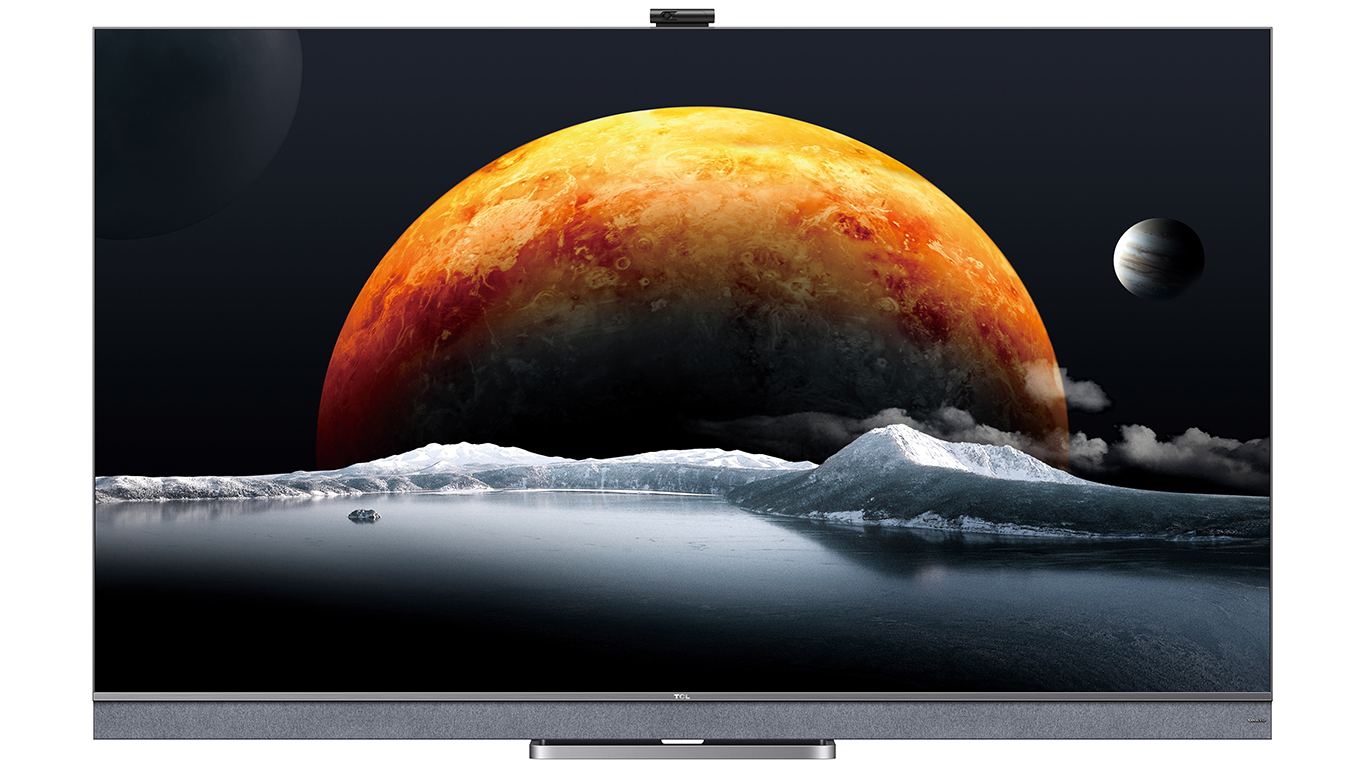
We had one problem with audio. We had our 4K Blu-ray player delivering audio directly (via coaxial digital) to our hi-fi amplifier. It revealed the delay induced by the TV – the audio came from our hi-fi speakers a good 300ms ahead of the picture, unbearably out of sync.
With no audio sync adjustment on the hi-fi amplifier, we sought a solution. Easiest would have been to run the optical output of the TV to the amplifier – the TV would delay the audio to match the video. But because the connections were on the right side of the TV, we didn’t have an optical cable long enough.
Then we remembered the TV’s gaming credentials – low lag, VRR and so on for the latest consoles. We switched to the Game picture mode, and presto, the video processing time was cut right back and the amp’s sound was now in sync. But much of the clever processing is unavailable in Game mode.
The other audio option is to stick with the Onkyo soundbar. It’s not going to rock your world with movie impact and megabass; it’s not even going to match many separate soundbars, let alone hi-fi speakers flanking your TV, but it is able to deliver good day-to-day sound and crank movies reasonably high, delivering an impressive spaciousness at best, such as during the spooky ‘don’t leave the path’ sequence in the second Hobbit movie.
Final verdict
The case for MiniLED seems proven by TCL’s C825. Get the picture settings right and you have blacks as black as we’ve seen anywhere except OLED, brightness levels and colours which pop as impressively as OLED, and with the image quality accompanied by all the advantages of Android (soon Google) TV – and a decent soundbar built in.
It’s also priced below the RRP of current-gen OLEDs. If the rest of the range performs as well as this 55-incher, TCL seems onto a winner here.
Sound+Image is Australia's no.1 mag for audio & AV – sister magazine to Australian Hi-Fi and to the UK's What Hi-Fi?, and bestower of the annual Sound+Image Awards, which since 1989 have recognised the year's best hi-fi and home cinema products and installations. While Sound+Image lives here online as part of our group, our true nature is best revealed in the print magazines and digital issues, which curate unique collections of content each issue under the Editorship of Jez Ford, in a celebration of the joys that real hi-fi and high-quality AV can bring. Enjoy essential reviews of the most exciting new gear, features on Australia's best home cinemas, advice on how to find your sound, and our full Buying Guide based on all our current and past award-winners, all wrapped up with the latest news and editorial ponderings. Click here for more information about Sound+Image, including links to buy individual digital editions and details on how best to subscribe.
